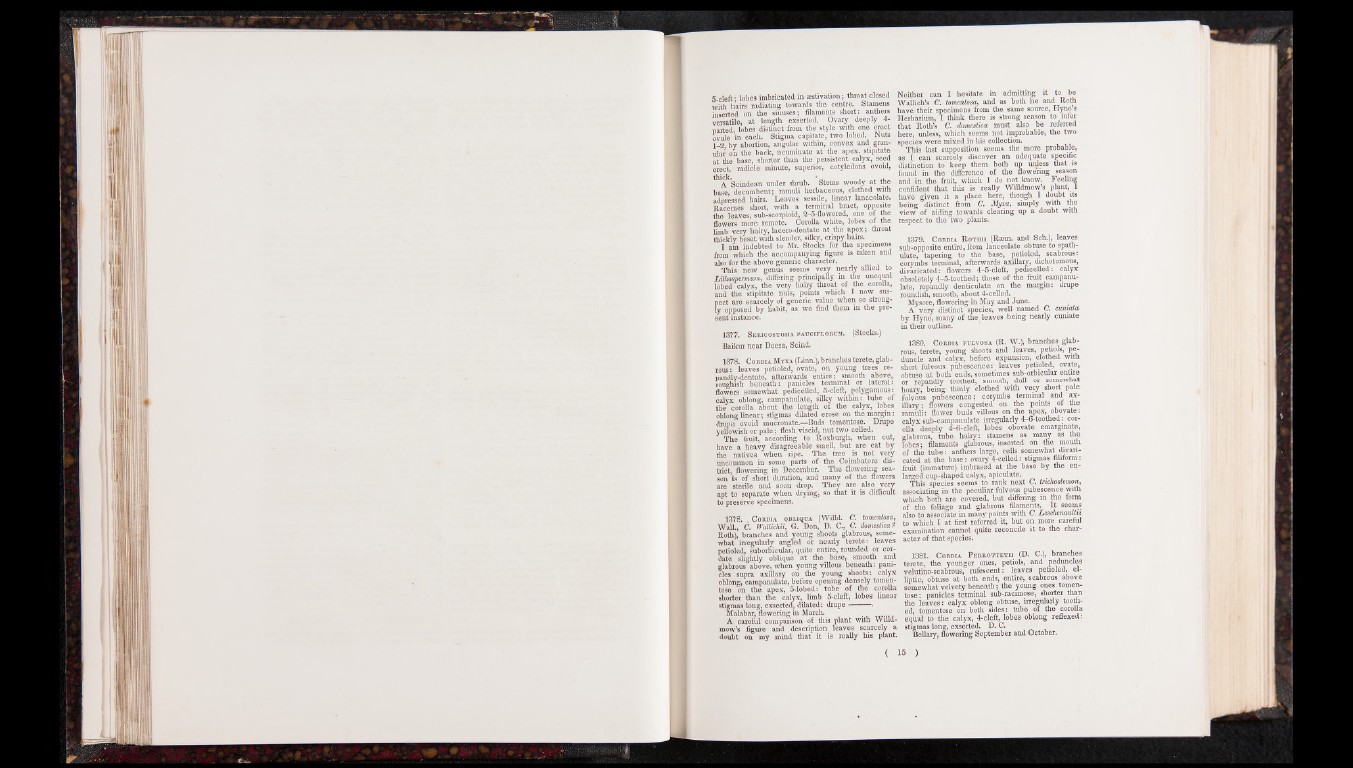
5-cleft; lobes imbricated in «estivation; throat closed
with hairs radiating towards the centre. Stamens
inserted on the sinuses; filaments short: anthers
versatile, at length exserted. Ovary deeply 4-
parted, lobes distinct from the style with one erect
ovule in each. Stigma capitate, two lobed. Nuts
1-2 by abortion, angular within, convex and granular
on the back, acuminate at the apex, stipitate
at the base, shorter than the persistent calyx, seed
erect, radicle minute, superior, cotyledons ovoid,
thAk’Scindean under shrub. Stems woody at the
base decumbent; ramuli herbaceous, clothed with
adpressed hairs. Leaves sessile, linear lanceolate.
Racemes short, with a terminal bract, opposite
the leaves, sub-scorpioid, 2—5-flowered, one of • the
flowers more remote. Corolla white, lobes of the
limb very hairy, lacero-dentate at the ap ex; throat
thickly beset with slender, silky, crispy hairs.
I am indebted to Mr. Stocks for the specimens
from which the accompanying figure is taken and
also for the above generic character.
This new genus seems very nearly allied to
Lithospermum, differing principally in the unequal
lobed calyx, the very hairy throat of the corolla,
and the stipitate nuts, points which I now suspect
are scarcely of generic value when so strongly
opposed by habit, as we find them in the present
instance.
1377. Sericostoma pauciflorum. (Stocks.)
Baikur near Deesa, Scind.
1378. Cordia Mtxa (Linn.), branches terete, glabrous:
leaves petioled, ovate, on young trees re-
pandly-dentate, afterwards entire; smooth above,
roughish beneath: panicles terminal or lateral:
flowers somewhat pedicelled, 5-cleft, polygamous:
calyx oblong, campanulate, silky within: tube of
the corolla about the length of the calyx, lobes
oblong linear; stigmas dilated erose on the margin:
drupe ovoid mucronate.—Buds tomentose. Drupe
yellowish or pale; flesh viscid, nut two celled.
The fruit, according to Roxburgh, when cut,
have a heavy disagreeable smell, but are eat by
the natives when ripe. The tree is not very
uncommon in some parts of the Coimbatore district,
flowering in December. The flowering season
is of short duration, and many of the flowers
Neither can I hesitate in admitting it to be
Wallich’s C. tomentosa, and as both he and Roth
have their specimens from the same source, Hyne’s
Herbarium, I think there is strong reason to infer
that Roth’s C. domestica must also be referred
here, unless, which seems not improbable, the two
species were mixed in his collection.
This last supposition seems the more probable,
as I can scarcely discover an adequate specific
distinction to keep them both up unless that is
found in the difference of the flowering season
and in the fruit, which I do not know. Feeling
confident that this is really Willdmow’s plant, I
have given it a place here, though I doubt its
being distinct from C. Myxa, simply with the
view of aiding towards clearing up a doubt with
respect to the two plants.
are sterile and soon drop. They are also very
apt to separate when drying, so mat it is difficult
to preserve specimens.
1378. Cordia obliqua (Willd. C. tomntosa,
Wall., C. Wallichii, G. Don, D. C., C. domestical
Roth), branches and young shoots glabrous, somewhat
irregularly angled or nearly terete: leaves
petioled, suborbicular, quite entire, rounded or cordate
slightly oblique at the base, smooth and
glabrous above, when young villous beneath: panicles
supra axillary on the young shoots: calyx
oblong, campanulate, before opening densely tomentose
on the apex, 5-lobed: tube of the corolla
shorter than the calyx, limb 5-cleft, lobes linear
stigmas long, exserted, dilated: drupe----------.
Malabar, flowering in March. _
A careful comparison of this plant with Willd-
mow’s figure and description leaves scarcely a
doubt on my mind that it is really his plant.
1379. Cordia Rothii (R«em. and Sch.), leaves
sub-opposite entire, from lanceolate obtuse to spath-
ulate, tapering to the base, petioled, scabrous:
corymbs terminal, afterwards axillary, dichotomous,
divaricated: flowers 4-5-cleft, pedicelled: calyx
obsoletely 4-5-toothed; those of the fruit campanulate,
repandly denticulate on the margin: drupe
roundish, smooth, about 4-celled.
Mysore, flowering in May and June.
A very distinct species, well named C. cumala
by Hyne, many of the leaves being nearly cuniate
in their outline.
1380. Cordia fulvosa (R. W.), branches glabrous,
terete, young shoots and leaves, petiols, peduncle
and calyx, before expansion, clothed with
short fulvous pubescence: leaves petioled, ovate,
obtuse at both ends, sometimes sub-orbicular entire
or repandly toothed, smooth, dull or somewhat
hoary, being thinly clothed with very short pale
fulvous pubescence; corymbs terminal and axillary
; flowers congested on the points of the
ramuli: flower buds villous on the apex, obovate:
calyx sub-campanulate irregularly 4-6-toothed: corolla
deeply 4-6-cleft, lobes obovate emarginate,
glabrous, tube hairy: stamens as many as the
lobes; filaments glabrous, inserted on the mouth
of the tube: anthers large, cells somewhat divaricated
at the base: ovary 4-celled: stigmas filiform:
fruit (immature) imbrased at the base by the enlarged
cup-shaped calyx, apiculate.
This species seems to rank next C. tnchostemon,
associating in the peculiar fulvous pubescence with
which both are covered, but differing in the form
of the foliage and glabrous filaments. It seems
also to associate in many points with C Leschenaultii
to which I at first referred it, but on more careful
examination cannot quite reconcile it to the character
of that species.
1381. Cordia Perrottetii (D. C.), branches
terete, the younger ones, petiols, and peduncles
velutino-scabrous, rufescent: leaves petioled, elliptic,
obtuse at both ends, entire, scabrous above
somewhat velvety beneath; the young ones tomentose:
panicles terminal sub-racimose, shorter than
the leaves: calyx oblong obtuse, irregularly toothed,
tomentose on both sides: tube of the corolla
equal to the calyx, 4-cleft, lobes oblong reflexed:
stigmas long, exserted. D. C.
Bellary, flowering September and October.